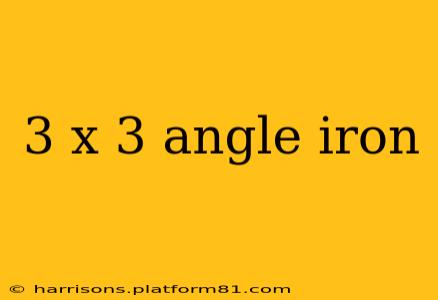Angle iron, a versatile structural component, finds applications across numerous industries. This guide focuses specifically on 3 x 3 angle iron, exploring its properties, uses, and considerations for selecting the right one for your project. Understanding its characteristics is crucial for ensuring structural integrity and successful project completion.
What is 3 x 3 Angle Iron?
3 x 3 angle iron refers to a type of structural steel with a cross-section shaped like an "L," where both legs measure 3 inches. This dimension refers to the nominal size; the actual dimensions may vary slightly depending on the manufacturer and the process used to create the angle iron. It's typically made from mild steel, offering a good balance of strength and weldability. The material's properties, such as yield strength and tensile strength, are essential factors in determining its suitability for various applications.
What are the different types of 3 x 3 angle iron?
Several factors differentiate types of 3 x 3 angle iron, influencing their applications and cost. These include:
- Material: While mild steel is common, other materials like stainless steel (offering superior corrosion resistance) or aluminum (lighter weight) are also available, though less frequently in this specific size.
- Thickness (Gauge): The thickness of the legs impacts the overall strength and weight of the angle iron. Thicker angle iron (lower gauge number) is stronger but heavier and more expensive. Thinner angle iron (higher gauge number) is lighter and less expensive but less structurally robust.
- Finish: Angle iron can be hot-dipped galvanized for corrosion protection, or left with a mill finish. The choice depends on the environment and the desired lifespan of the structure.
What is the weight of 3 x 3 angle iron?
The weight of 3 x 3 angle iron varies significantly based on its thickness (gauge). Thicker angle iron naturally weighs more per linear foot. To determine the exact weight, you'll need to consult the specifications provided by the manufacturer or a materials supplier. This information is typically available in weight charts or technical data sheets.
What are the uses of 3 x 3 angle iron?
3 x 3 angle iron's strength and versatility make it suitable for a wide range of applications:
- Structural Support: It's frequently used as framing for buildings, sheds, and other structures, providing support for walls, roofs, and other components.
- Fabrication: It serves as a base material for creating custom metal structures, gates, railings, and various fabricated parts.
- Machinery Bases: It forms a solid foundation for machinery and equipment, ensuring stability and preventing vibrations.
- Reinforcement: It can reinforce existing structures or provide additional support where needed.
Where can I buy 3 x 3 angle iron?
3 x 3 angle iron is widely available from various suppliers, including:
- Metal Supply Companies: These businesses specialize in selling steel and other metal products.
- Online Retailers: Many online retailers offer angle iron for sale, often with convenient delivery options.
- Local Hardware Stores: Larger hardware stores may carry smaller quantities of angle iron.
How much does 3 x 3 angle iron cost?
The cost of 3 x 3 angle iron varies depending on the factors mentioned earlier: material, gauge, length, finish, and market conditions. Contacting local suppliers for current pricing is recommended for the most accurate estimate. Bulk purchases often result in lower per-unit costs.
How do I cut 3 x 3 angle iron?
Cutting 3 x 3 angle iron requires appropriate tools and safety precautions. Common methods include:
- Angle Grinder with Abrasive Cut-off Wheel: A fast and effective method, requiring proper eye and hearing protection.
- Reciprocating Saw with Metal-Cutting Blade: A more portable option, but potentially slower than an angle grinder.
- Plasma Cutter: Provides precise cuts, especially beneficial for intricate shapes. Requires appropriate safety equipment.
This comprehensive guide provides a solid foundation for understanding 3 x 3 angle iron. Remember to always prioritize safety and select the appropriate type of angle iron based on your project's specific requirements. Consulting with a structural engineer is recommended for complex projects to ensure the structural integrity of your design.
